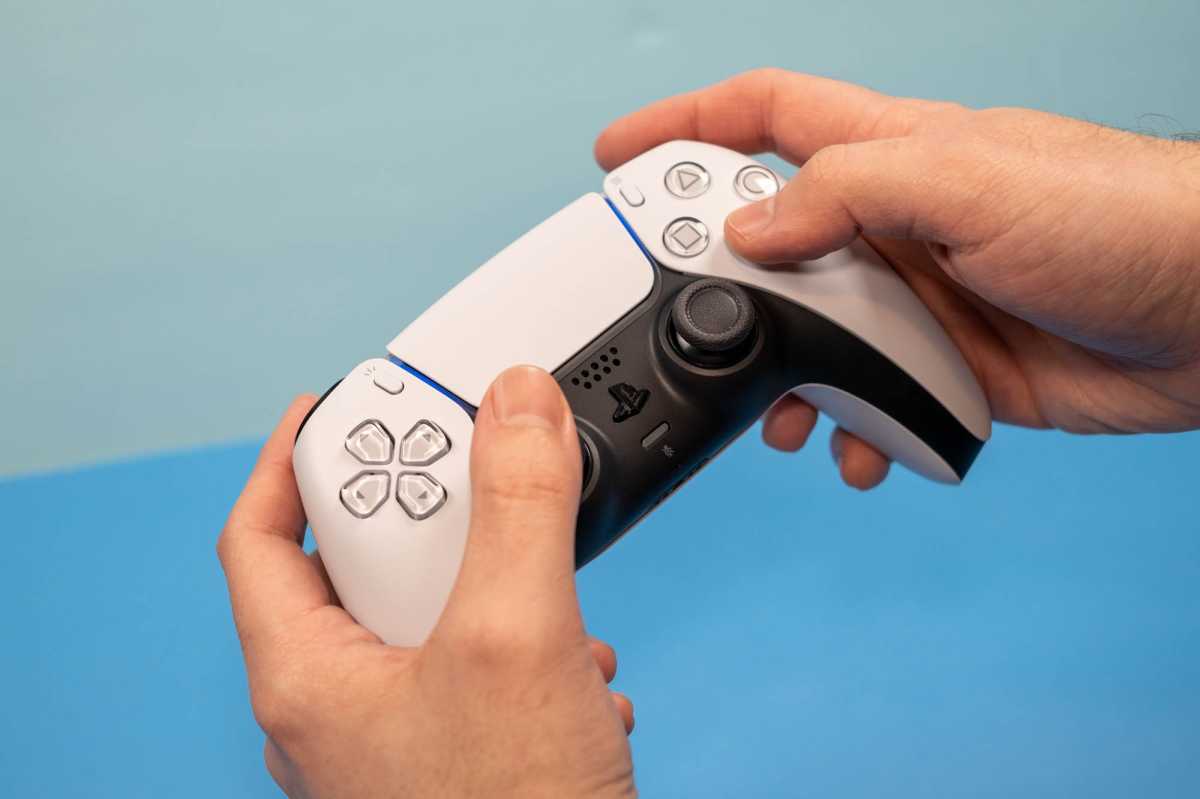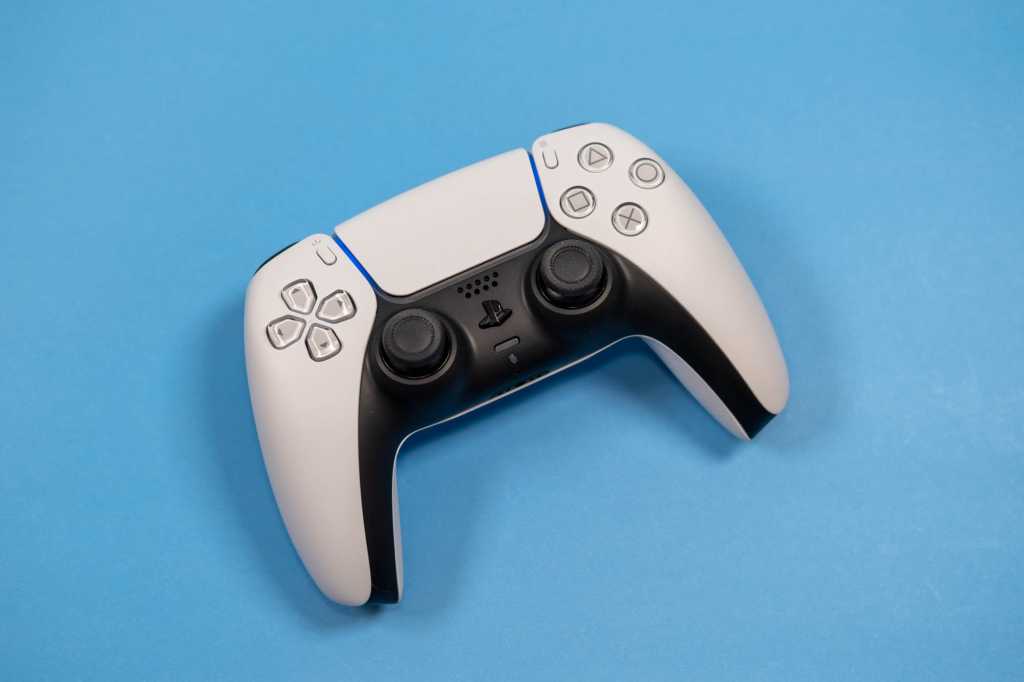Expert’s Rating
Pros
- Very comfortable in the hand
- Haptics and adaptive triggers are amazing
- Built-in speaker
Cons
- More expensive than an Xbox controller
- Short battery life
- Limited support on PC
Our Verdict
The DualSense controller feels great, and features like adaptive triggers are a real game-changer. However, PC support is lacking.
Price When Reviewed
$69
Best Prices Today: Sony DualSense controller
The providence of Sony’s DualSense controller is clear the instant you see it—this controller looks like an evolution of the older DualShock controllers Sony has used for the last 20 years. The grips extend downward from the main body of the controller, tapering more so than on the DualShock 4 and earlier iterations. On the right side, you have the standard Sony buttons: square, circle, x, and triangle. Opposite that is the d-pad. The directional arrows are all separated, which makes them very tactile and easy to press, but this design isn’t as good for fighting games or anything else where diagonal d-pad input is used.
Sony’s controller uses symmetrical thumbsticks as opposed to the offset sticks you see on all Xbox-style controllers. In the middle, you have a large clickable trackpad, which is sadly almost useless on PC. You also get a share button and menu/pause button on the face. Plus, there’s a tiny speaker dead center on the DualSense, which can add atmospheric sounds to your gameplay experience.
On the top edge, the DualSense looks more like your traditional game controller. Looks can be deceiving, though. There’s a single USB-C port, which will link your controller to a computer as well as recharge the integrated battery. You still have to pay extra to get rechargeable battery packs for the Xbox controller, but neither comes with a USB-C cable.
The shoulder buttons work as you’d expect, but the triggers are something special. Developers can change the amount of resistance for the triggers, making them feel different when performing different activities in the game. While you can’t tell just by looking at the exterior, the DualSense has enormous vibration motors in the grips. This allows the controller to create advanced haptic experiences, again, depending on developer support.
The matte plastic exterior is smoother than the Xbox controller, but it’s still sufficiently stable with the longer grips. Aesthetically, it’s an attractive piece of technology if you like the PlayStation 5’s look. There are no exposed screws, and many of the plastic seams are integrated with the design language to form PS5-style negative space and lighting bars. It’s a gamepad from the future.
Sony DualSense: Features and hands-on experience
Many gamers are entrenched in their controller layout preferences. If you’ve been using Xbox-style controllers for years, there might be a learning curve with the DualSense. Xbox fans shouldn’t discount this one, though. The DualSense weighs in at 281 grams, about the same as the current-gen Xbox controller. However, we found the DualSense to be more comfortable in the hand during long gaming sessions. The Xbox controller feels a bit chunky by comparison.
The buttons on the face are all tactile and easy to press, although the pause button is very flat and can be hard to find by feel. The thumbsticks have a grippy rubberized texture and just the right amount of resistance. It takes less force to click the sticks on Sony’s controller compared to Microsoft’s, but it’s not so little that you’ll do it by accident.
Ryan Whitwam / Foundry
The controller’s unique hardware works wirelessly with the PS5, but on PC, you’ll have to use a USB-C cable to get proper support in DualSense-optimized games. When a game supports the DualSense, it really elevates the experience. For example, Returnal uses the DualSense’s haptics to relay information about your character’s status and the environment. If you try to use your alt-fire before it’s recharged, the controller gives you an angry-feeling vibration in the trigger region. In places where it’s raining, the advanced haptics can even simulate the feeling of raindrops hitting the controller. Combined with the speaker, the DualSense makes for a much more immersive experience.
The adaptive triggers are even more impressive than the haptics. Without adjustment, the triggers are smooth and easy to press, with about the same travel as the Xbox controller. Games can ramp up the resistance to make in-game activities feel more real, but the trigger adjustment can also be functional. Going back to Returnal, the developers created a two-stop button out of the left trigger. Depress it to the first stop, and your character aims for increased precision. Push past the tactile bump, and you activate alt-fire mode. It’s extremely cool and useful in a fast-paced title like Returnal.
In wireless mode, we’re averaging around eight hours of gameplay per charge, which is far short of the 25 to 30 hours you get with the Xbox controller. Granted, the DualSense does a lot more, but the enhanced haptics and triggers only work in select games and over a wired connection. That makes wireless mode on PC underwhelming.
As a piece of hardware, the DualSense is far superior to the current Xbox offerings. It’s more comfortable, the buttons feel better, and features like adaptive triggers are revolutionary.
Sony DualSense: Compatibility
Naturally, the DualSense works best with the PS5. The trackpad, adaptive triggers, and haptics are utilized in almost all games, and you can play wirelessly. Connecting the DualSense to a PC over Bluetooth is quick and easy, but it will only be detected as a generic game controller. Steam lets you map Xbox controls onto to DualSense, so all controller-optimized games will at least understand it as an input device.
There are about 30 total games on PC that support DualSense haptics and/or adaptive triggers. Most of them are PlayStation ports like Marvel’s Spider-Man Remastered and the aforementioned Returnal. In all other PC games, the DualSense works like a regular controller with no special features. Although, it’s a pretty comfortable one.
If you’re playing a game without DualSense support, you can play wirelessly and not lose anything. However, you should stick to wired input for DualSense-supporting games. We would love to see Sony unlock the DualSense experience over Bluetooth for PCs. In the meantime, the third-party DualSenseX software can make the controller more useful on Windows, but it takes a lot of tinkering to get it working correctly.

Ryan Whitwam / Foundry
Should you buy a Sony DualSense?
The DualSense is a very impressive gamepad, marrying hardware and software to enable more immersive gameplay. As a piece of hardware, the DualSense is far superior to the current Xbox offerings. It’s more comfortable, the buttons feel better, and features like adaptive triggers are revolutionary. Sony’s precise, immersive haptics are on a different level compared to other controllers, which just rumble at varying intensities. It’s like comparing iPhone haptics to any other phone—there is no comparison.
We like that Sony’s controller comes with a built-in rechargeable battery, but the battery life could be better. At about eight hours per charge, you’d do well to pick up a charging dock so you don’t forget to juice up the gamepad when you’re not playing. You’ll also need to provide your own USB-C cable, as the controller doesn’t come with one.
However, you’ll only get the best experience on the PlayStation 5. Only a handful of PC games support the controller’s advanced features, and they all require a wired connection. Over Bluetooth, the DualSense is just a generic controller. The Sony DualSense is the premium controller that PC gamers deserve. But sadly, the support isn’t there yet.

